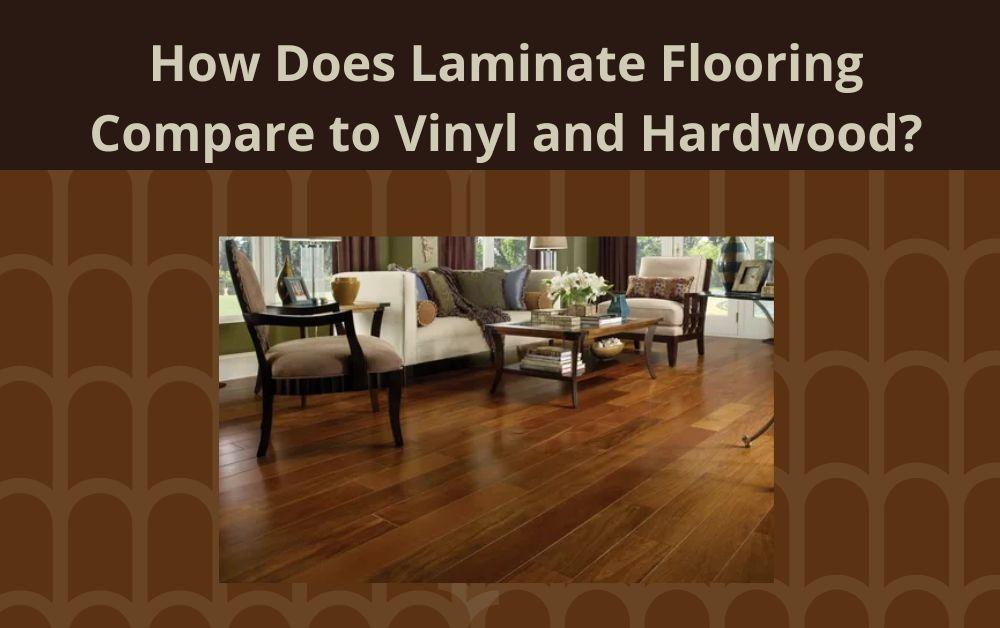Flooring plays a big role in the comfort, look, and value of any home or office. It is the foundation of interior design, and choosing the right type of flooring can completely change how your space feels. Many people find it difficult to decide between laminate, vinyl, and hardwood when planning a new floor.
Each option has its own beauty, cost range, durability, and maintenance needs. Laminate flooring, however, stands out as one of the most practical and stylish choices for modern spaces. In this article, we will explore how laminate flooring compares to vinyl and hardwood, helping you make a simple, clear, and confident choice for your next flooring project.
Understanding Each Type of Flooring
Note : Laminate flooring in Dubai offers stylish, durable, and easy-to-maintain flooring solutions perfect for both homes and offices.
What Is Laminate Flooring?
Laminate flooring is a multi-layered product made from high-density fiberboard, decorative image layers, and a protective surface coating. The top layer is printed with realistic wood or stone patterns, giving the look of natural material without the high price. The surface is covered with a protective layer that helps resist scratches, stains, and fading.
Laminate floors are popular because they combine the warmth and natural appearance of wood with easy installation and low maintenance. They are suitable for homes, offices, and commercial spaces where both style and strength are important.
What Is Vinyl Flooring?
Vinyl flooring is made from synthetic materials such as PVC. It has become more advanced over the years and now comes in different forms, including luxury vinyl planks (LVP) and tiles (LVT). Vinyl is flexible, entirely waterproof, and comfortable to walk on. It is a strong competitor to laminate in areas like kitchens, bathrooms, and laundry rooms.
What Is Hardwood Flooring?
Hardwood flooring is made from natural wood planks that are either solid or engineered. It offers rich, long-lasting beauty and is considered a premium option. Each plank of hardwood has a unique grain pattern, adding luxury and natural charm. However, hardwood usually needs more maintenance and care to prevent damage from moisture or scratches.
Comparing Look and Design Options
Appearance and Realistic Finish
Laminate flooring has made major improvements in design over the years. Modern printing technology allows laminates to replicate both the texture and color patterns of real wood or stone. It’s often difficult to tell it apart from real hardwood once installed.
Vinyl flooring also offers realistic designs but sometimes lacks the detailed texture of good-quality laminate. Hardwood, being natural, provides an authentic and unique look that synthetic materials try to copy.
Variety and Style Choices
Laminate and vinyl both come in a wide range of colors, textures, and wood-look finishes—oak, walnut, maple, or grey tones. You can match them with nearly any style of interior décor. Hardwood offers timeless elegance, but its color and tone are limited to the type of wood used. While hardwood is beautiful, laminate offers more variety at a lower cost.
Durability and Strength
Scratch and Wear Resistance
Laminate is made with a strong wear layer on top that protects it from scratches, dents, and fading. It is perfect for busy homes with children or pets. Hardwood, although sturdy, can scratch more easily and may need sanding or refinishing to look new again.
Vinyl flooring is softer than laminate, which makes it prone to damage from sharp objects but more comfortable underfoot. In terms of long-term durability, both laminate and vinyl perform well in different ways—laminate for scratch resistance and vinyl for waterproofing.
Moisture and Water Resistance
Hardwood flooring is sensitive to moisture. Too much water can cause it to swell, warp, or stain. Laminate flooring is more water-resistant than wood but not fully waterproof. Spills should be cleaned quickly to prevent water from seeping through the seams.
Vinyl flooring is completely waterproof, making it ideal for kitchens, bathrooms, and laundry areas. If water resistance is your top concern, vinyl has the clear advantage. However, for living rooms, bedrooms, and offices, laminate provides a more natural and comfortable finish.
Installation Process
Ease of Installation
Laminate flooring is easy to install because most modern types use a click-lock system. The planks snap together without glue or nails and can be placed over an existing subfloor. Even homeowners with basic DIY skills can install laminate flooring themselves.
Vinyl planks can also be installed with a similar locking system, though some types require adhesive. Hardwood installation, on the other hand, is more complex. It usually requires professional tools, nails, and precise fitting to ensure the planks sit perfectly.
Time and Effort
Installing laminate or vinyl takes less time compared to hardwood, which needs sanding, sealing, and sometimes long drying periods. If you want a quick and clean flooring job, laminate is an excellent choice.
Comfort and Feel Underfoot
Walking Comfort
Laminate flooring feels firm and stable, giving a solid walking experience similar to hardwood. Vinyl has a softer, slightly cushioned feel since it is flexible. Hardwood is a natural material with a warm, rich touch, but it depends on the subfloor and room temperature.
Sound and Insulation
Laminate flooring can be a bit noisy underfoot, especially if not installed with proper underlayment. Modern laminates can include built-in soundproof layers that reduce noise. Vinyl generally absorbs more sound because of its softer composition. Hardwood feels rich and natural but may also creak over time.
Maintenance and Cleaning
Daily Cleaning
Laminate flooring is very easy to maintain. Regular sweeping or vacuuming and occasional mopping with a damp cloth keep it clean. Do not use excessive water, as it can affect the boards.
Vinyl is the easiest of all to clean. Its waterproof nature allows for simple mopping, even with water. Hardwood requires more care – cleaning with suitable wood products, avoiding water spills, and periodic polishing to maintain its beauty.
Long-Term Care
Laminate doesn’t require polishing or waxing. The protective top layer keeps it looking new for years. Vinyl also keeps its shine without much effort. Hardwood, however, may need sanding and refinishing every few years to maintain its smooth appearance.
Cost Comparison
Material Cost
Laminate flooring is generally more affordable than hardwood and sometimes cheaper than high-end vinyl. You can get the elegant look of natural wood without paying a high price. Vinyl ranges from low-cost options to premium luxury varieties, depending on thickness and brand. Hardwood remains the most expensive because it’s made from real wood.
Installation and Maintenance Cost
Both laminate and vinyl cost less to install compared to hardwood. Hardwood installation often requires skilled labor and special finishing processes. In maintenance, laminate and vinyl also save you money as they don’t need refinishing or complex treatments.
Environmental and Health Factors
Eco-Friendliness
Laminate flooring is often made from recycled fiber materials, making it an eco-conscious option. Many manufacturers use environmentally friendly production methods. Vinyl, being plastic-based, is less eco-friendly, though modern versions try to reduce their carbon footprint.
Hardwood is natural but not always sustainable unless it comes from responsibly managed forests. Choosing laminated wood products made from recycled materials often provides a greener flooring choice.
Indoor Air Quality
Laminate and vinyl flooring now come with low-emission certifications, meaning they emit very little or no harmful gases into indoor air. Hardwood is naturally safe, but the sealants and finishes sometimes used on it may contain chemicals that affect air quality if not properly handled.
Best Use Areas for Each Flooring Type
Where Laminate Works Best
Laminate flooring fits perfectly in living rooms, bedrooms, offices, and hallways. It withstands heavy foot traffic and adds a warm, stylish look to interiors.
Where Vinyl Excels
Vinyl flooring is perfect for bathrooms, kitchens, and laundry rooms where water exposure is common. It’s great for families looking for waterproof and easy-to-clean flooring.
Where Hardwood Shines
Hardwood flooring works beautifully in living areas, dining rooms, and entryways where it adds luxury and long-term property value. It’s ideal for those who prefer natural materials and don’t mind a bit of maintenance.
Which Flooring Is Right for You?
If your top priority is elegance and natural authenticity, hardwood is unmatched. If you want something modern, practical, and cost-effective, laminate flooring is your best choice. For spaces with high moisture levels, vinyl flooring is the most suitable.
It all depends on where you plan to use it, your budget, and how much maintenance effort you can manage. In places like Dubai or humid climates, laminate and vinyl both perform better than natural wood because they handle heat and moisture more efficiently.
Conclusion:
When comparing laminate, vinyl, and hardwood, each type brings unique benefits. Hardwood wins in natural beauty, vinyl wins in water resistance, and laminate stands strong as the perfect middle ground.
Laminate flooring offers the charm of wood, the toughness of modern materials, and the simplicity every homeowner appreciates. It’s affordable, easy to maintain, and built to handle daily life while looking elegant. Whether you are updating your home or designing a new commercial space, laminate flooring gives you style, durability, and value all in one smart choice.



